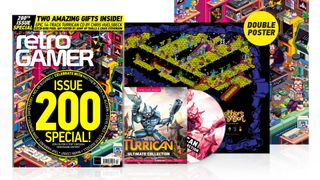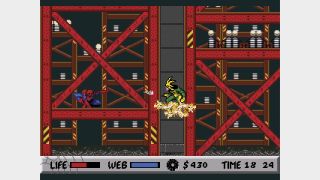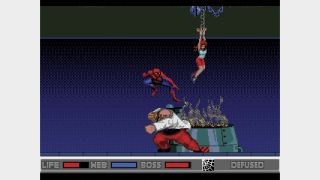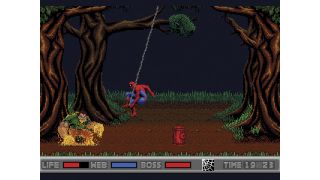Way before Insomniac Games' excellent Spider-Man on PS4 (2018), or the surprisingly decent Spider-Man 2 by Tony Hawk developers Treyarch, which debuted on PS2, Xbox and Gamecube (2004) - before being ported to some surprise formats including the Nokia N-Gage - the web swinger had struggled to translate his abilities into a video-game. Swinging even further back to the 1980s, Marvel Comics didn't have the greatest of success with videogames, aside from a trio of well-received graphic adventures. At the dawn of the 1990s, however, a contract with Sega Of America to publish a Spider-Man game for the-then cutting-edge Sega Genesis (Sega Mega Drive in the UK) seemed like a sure thing. Unfortunately, Sega's first choice of developer – an east coast outfit called Innerprise Software – failed to make progress quickly enough, and so the Spider-Man licence was handed over to the west coast developer Technopop, which although starting from scratch, made real headway before internal and inter-company disputes resulted in the firm imploding.
With time in short supply, former Technopop coder Burt Sloane was asked to take on the licence himself, although as developer Jon Miller explains, Burt soon saw the benefits of having a partner. "Burt was roommates with my brother Mark, who was working on the music and sound effects for the game," Jon begins. "I was on the east coast in Boston, and they were in San Francisco. I had been talking to my brother, he’d been telling me about what he was doing, and it sounded a lot more fun than what I was doing. After the Technopop split up, Burt was the only programmer, and he thought he needed some help."
Soon after Jon joined Burt, however, it became apparent that Technopop had made more progress on some aspects of the Spider-Man licence than others, with the result that its levels and gameplay fell short of its beautifully animated, comic book-faithful lead character, not to mention the game’s eastern inspiration. "I contracted with Sega to help get it out the door," Jon recalls, "but it hadn't been optimised to ship – it wasn't hitting its target framerate, it didn't fit into the cartridge size allocated to the game and at the same time it wasn’t large enough. One of the inspirations was the Revenge of Shinobi game that came out of Japan. That was just a really slick, beautifully done, beautifully-tuned side-scrolling game; that was the inspiration for how things should work."

Love retro gaming? From SNES to Mega Drive, PSOne to Xbox, and Spectrum to C64, Retro Gamer magazine delivers amazing features and developer interviews about history's best games every month, and you can save up to 57% on a print and digital subscription right now.
The daunting challenge of elevating the quality of Sega's Spider-Man project while at the same time expanding its world and reducing its file size didn’t go unnoticed by the game's developer turned producer Ed Annunziata, who responded by pitching in. "Burt had made these tools for the Macintosh," Jon notes. "His previous gig had been working with Apple in the Mac group, so he was familiar with doing GUIs. There was a level editor that let you quickly scroll around, zoom in and out, copy and paste regions of tiles, and attach collision and enemy information graphically. So he gave a copy of these tools to Ed, and Ed helped expand the size of some of the levels."
Signature moves

One outcome of this focus on level design was the realisation that Spidey's signature moves suited different environments, so stages became increasingly tailored to certain abilities. "There were plenty of levels – like the initial warehouse scene – where there were a lot of vertical walls and platforms that you had to jump between," Jon observes. "You could swing, but it moved you too fast and without enough control, so you ended up crawling. There was a lot of serendipity; it was difficult to plan that out on paper. And so you built stuff with what you thought was going to work with the mechanics and you would try it."
A key mechanic in Spider-Man's evolving Mega Drive debut was based on his uncanny ability to spin webs and swing from them, which seems like a developer’s dream but actually caused a few nightmares. "One of the things that was great was the 'swinging from the web' mechanic," Jon enthuses. "It was pretty cool; it was something that was unusual, and I think it worked well, but the problem was that it allowed you to traverse huge distances very quickly. So you could jump and swing over everything, and that was a little bit of a challenge. So Ed took the sewer scene, and he kept adding regions off to the sides to swing into."
Of course, the ever-expanding sewer level required opponents for Spider-Man to fight, which ranged from mutants to alligators. The stage finished with a super-villain boss, in keeping with all of the other levels in the evolving game. "Obviously the villains in the comic books lent themselves beautifully to being the bosses in the game," Jon points out. "There were some places where there were obvious things you could do, like the Lizard could swing around and swat with his tail – so that gave a nice, quick distance attack. And then Electro – he could squat down and electrify the girders, which was also a great foil for the ‘sticking to walls’ mechanic."
As well as systems based on Spider-Man’s abilities, an additional mechanism was devised using static sprites and background tiles, which took inspiration from Peter Parker's talent for taking shots of his battles as Spidey and selling them for web-fluid money. "The storyline was interesting in that Peter Parker was a photographer," Jon reflects, "so was there a way to pull that into the game mechanics? And then it was also just a cool technical thing to be able to do. The Mega Drive was not a bit-map machine, so what Burt did for the photos was actually a lot more complex. I think that was a kind of surprise when you were playing the game and saw the photo get captured like that."
Satisfying difficulty

A second surprise awaited players in the form of a gruelling finale involving the dramatic rescue of Spider-Man's girlfriend and a brutal showdown with the criminal genius underpinning the plot in Spidey's inaugural Mega Drive title – the Kingpin, the difficulty of which Jon puts down to expediency. "There was one number somewhere that said how many times you had to hit a boss, and you could turn that up high. It wasn’t necessarily the most satisfying way of creating difficulty, but you wanted your final boss to be the most spectacular of your efforts and the hardest to play. Between trying to make it interesting graphically by having a lot of stuff on the screen and wanting it to be tuned to be hard that’s why we ended up with it like that."
In addition to providing Spider-Man with a punishing boss fight, the Kingpin also headlined Sega's game – Spider-Man Vs The Kingpin, although the fact that its box-art simply read 'Spider-Man' did nothing to hinder the success of the game on release. "It was a hit game; it sold a lot of copies," Jon confirms. "That one felt like pretty much a hands-down success. I remember going into Toys R Us and seeing the game featured in the racks of videogames – that was a trip! It was the first game that Burt and I – and my brother – had ever been involved with, so it felt like a pretty great first accomplishment. The game was very good, and then you had the most killer license that you could get your hands on, so it made quite a combination."
On reviewing Spider-Man's introduction to the Mega Drive now, Jon expresses pride, but gives most of the credit to Marvel for creating such a videogame-friendly character and his former coding partner Burt Sloane for taking the lead on the project. "The Marvel licence came with a bunch of ideas that were just part of the storyline, part of the character," Jon acknowledges, "and I think Burt did a good job capturing things like the web-shots and the web-swinging and sticking to walls. Those all gave it a little different feel than some of the other fare coming out at the time, and I’m proud of the contribution I made; it was definitely great to have my name put on that."
But returning back to the year after the release of Spider-Man Vs The Kingpin, there's a second chapter to the game's story. Around this time, a team led by Burt Sloane were tasked with reimagining the hit title for a newly released Mega Drive add-on, as team member David Foley recollects. "The biggest thing for Sega was that it had the Mega-CD, which was not very commercially successful," David observes, "so it was dying for content and asked what we could do that was quick. Spider-Man was a big title for Sega, and knowing that we had done levels and characters that had to get cut in order to fi t the cartridge the producers knew we had more that could be put in as bonuses without a lot of time and effort on the creative side."
CD Power

But far from merely reinstating cut content, Burt and his team gave their lead character Spider-Man more fighting moves and made him and his superpowered foes move faster and more smoothly, which as David explains was facilitated by better software and hardware. "A lot of enhancements were able to take advantage of having a little more horsepower, and the engine had matured quite a bit in that timeframe too. We had the Mega-CD, and we literally couldn’t think of things to fill it up with. We were going from kilobytes to megabytes, so anything you had you could throw at it. You could do a lot more moves because you had a lot more storage, so instead of a four-frame walk sequence you could put in an 18-frame walk sequence, and instead of having only one punch, you could have several different punches."
In addition to greatly enhancing the characters from the Mega Drive original, Burt's Mega-CD team also found time to add two extra stages with new bosses Vulture and Mysterio, and to flank the Kingpin with the super-villains Bullseye and Typhoid Mary. "With new characters, it was really a matter of trying to make sure that they fitted in with the artistic style so that we weren’t completely redrawing the game," David reasons, "and then following the direction of the producer by asking: 'What do you want us to add?' It was starting with what would be the coolest things we could do – like the Vulture flying around – and then, within the limitations of what the engine could perform, what could we actually pull off?"
Due consideration was also given to owners of the Spider-Man cartridge, which resulted in a map of boss-controlled areas that players of the CD version could choose from. "The producer was assuming that the game had been played by most players, that the first time they were visiting this property wouldn’t be on the Mega-CD," David acknowledges. "This was going to be more: 'I want to play this level again, and I want to be able to access everything.' Maybe they wanted to play one of the old levels or play a certain boss, but not be forced through the entire game. So the onus of having to have 40 hours of gameplay to get to the end was lifted off the player in the CD version."
Besides making gameplay improvements, the developers under Burt's charge also produced fullscreen animated cutscenes in order to take advantage of the Mega-CD's extra storage space, which in hindsight David is quite humble about. "It was really a matter of giving an artist a sequence to render and then how do we compress that down to play back? The good news was that we didn’t have to be that efficient because even blown-out the actual game only took about a megabyte of the 650 that we had on the CD. You’ve also got to remember that the resolution was pretty crap, so the video wasn’t taking a lot of space. I don’t know if it added anything to the game, but it was a time where video was really cool. So I think the wow factor was there just because you had streaming video at all."
The golden age

Equally impressive was the rock guitar CD soundtrack produced especially for Spider-Man’s Mega-CD outing, which David recalls preferring to the chip tunes in the original game. "Obviously you were getting a huge improvement just because you’re going from the horrible audio chip in the machine, which was just basically tones, to actual audio files. So I think that was a huge leap."
A final innovation involved a competition to win Marvel books and other prizes, which was open to players who could collect 21 reproduction comic book covers on 'nightmare' difficulty, although surprisingly Marvel didn’t suggest this feature. "I don’t know about the participation level, but I know that concept came from the producer from Sega," David muses. "This was the golden age of licences, where comic book companies or movie studios had very little input. So Marvel would take a look at it, but they were just happy to get a license out of it."
After gaining Marvel's – and Sega's – approval the retitled The Amazing Spider-Man Vs The Kingpin hit shop shelves where it was well received by Mega-CD owners and reviewers alike, although its creators were left to guess how well it sold. "I thought it was pretty soft," David considers, "but then again, we didn’t have any insight into how many units of Mega-CDs were selling at the time. But we got a lot of positive feedback from Sega; it really liked the release. And we would have heard if it wasn’t pleased with the sales – it was very much that the accolades were minimal, but the complaints were always very vocal."
With hindsight, David feels that if the narrative for the Mega-CD Spidey title that he worked on more than 15 years ago had been slightly tweaked it may have netted further assignments from Marvel for Burt Sloane’s team. "I would have done a lot more cliffhanger work to try and spawn more Spider-Man projects," David concedes. "Maybe bring in some characters that weren’t in the gameplay, villains that would make a cameo to hint that they would be in the next release. I’d set things up for a sequel to try to secure some more work for us."
But besides this regret, David looks back with satisfaction on his part in adapting and enhancing the Mega Drive hit. "It was a pretty neat release. It was early on in the life of the Mega-CD, and it was late on for the Mega Drive, but I think we kept true to the original game and made enhancements that made it worthwhile to the players. Sega was looking for a quick release – not a two-year project or something, and so I think it came out great in terms of the time constraints. It gave players the ability to play the extra stuff but also jump around and replay some of their favourites."
This feature first appeared in Retro Gamer issue 180. For more excellent features like the one you've just read, don't forget to subscribe to the print or digital edition at MyFavouriteMagazines.

